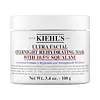What's inside
What's inside
 Key Ingredients
Key Ingredients

 Benefits
Benefits

 Concerns
Concerns

 Ingredients Side-by-side
Ingredients Side-by-side

Water
Skin ConditioningGlycerin
HumectantCaprylic/Capric Triglyceride
MaskingCetearyl Alcohol
EmollientPropanediol
SolventButyrospermum Parkii Butter
Skin ConditioningSqualane
EmollientDicaprylyl Carbonate
EmollientGlyceryl Stearate
EmollientCellulose
AbsorbentCetearyl Glucoside
EmulsifyingPassiflora Edulis Seed Oil
EmollientPelargonium Graveolens Flower Oil
MaskingRosa Damascena Flower Oil
MaskingLavandula Angustifolia Oil
MaskingLavandula Hybrida Oil
EmollientGlycine Soja Oil
EmollientCoriandrum Sativum Seed Oil
EmollientSimmondsia Chinensis Seed Oil
EmollientRosmarinus Officinalis Leaf Oil
MaskingOenothera Biennis Oil
EmollientZinc Gluconate
Skin ConditioningSodium Polyacrylate Starch
AbsorbentSilica
AbrasiveAdenosine
Skin ConditioningCaprylyl Glycol
EmollientCitric Acid
BufferingXanthan Gum
EmulsifyingTocopherol
AntioxidantSalicylic Acid
MaskingBenzoic Acid
MaskingCI 77007
Cosmetic ColorantLinalool
PerfumingGeraniol
PerfumingCitral
PerfumingCitronellol
PerfumingWater, Glycerin, Caprylic/Capric Triglyceride, Cetearyl Alcohol, Propanediol, Butyrospermum Parkii Butter, Squalane, Dicaprylyl Carbonate, Glyceryl Stearate, Cellulose, Cetearyl Glucoside, Passiflora Edulis Seed Oil, Pelargonium Graveolens Flower Oil, Rosa Damascena Flower Oil, Lavandula Angustifolia Oil, Lavandula Hybrida Oil, Glycine Soja Oil, Coriandrum Sativum Seed Oil, Simmondsia Chinensis Seed Oil, Rosmarinus Officinalis Leaf Oil, Oenothera Biennis Oil, Zinc Gluconate, Sodium Polyacrylate Starch, Silica, Adenosine, Caprylyl Glycol, Citric Acid, Xanthan Gum, Tocopherol, Salicylic Acid, Benzoic Acid, CI 77007, Linalool, Geraniol, Citral, Citronellol
Water
Skin ConditioningLauryl Laurate
Skin ConditioningSqualane
EmollientIsononyl Isononanoate
EmollientBehenyl Behenate
EmollientSorbitan Olivate
EmulsifyingSorbitan Stearate
EmulsifyingPolyhydroxystearic Acid
EmulsifyingCandelilla Cera
EmollientPropanediol
SolventPhenoxyethanol
PreservativeSodium Polyacrylate
AbsorbentChlorphenesin
AntimicrobialEthylhexylglycerin
Skin ConditioningPseudoalteromonas Ferment Extract
HumectantSalicylic Acid
MaskingSodium Hydroxide
BufferingWater, Lauryl Laurate, Squalane, Isononyl Isononanoate, Behenyl Behenate, Sorbitan Olivate, Sorbitan Stearate, Polyhydroxystearic Acid, Candelilla Cera, Propanediol, Phenoxyethanol, Sodium Polyacrylate, Chlorphenesin, Ethylhexylglycerin, Pseudoalteromonas Ferment Extract, Salicylic Acid, Sodium Hydroxide
 Reviews
Reviews

Alternatives
Ingredients Explained
These ingredients are found in both products.
Ingredients higher up in an ingredient list are typically present in a larger amount.
Propanediol is an all-star ingredient. It softens, hydrates, and smooths the skin.
It’s often used to:
Propanediol is not likely to cause sensitivity and considered safe to use. It is derived from corn or petroleum with a clear color and no scent.
Learn more about PropanediolSalicylic Acid (also known as beta hydroxy acid or BHA) is a well-known ingredient for treating skin that struggles with acne and clogged pores. It exfoliates both the skin's surface and deep within the pores to help clear out buildup, control oil, and reduce inflammation.
Unlike AHAs (alpha hydroxy acids), salicylic acid is oil-soluble. This allows it to penetrate into pores which makes it especially effective for treating blackheads and preventing future breakouts.
Salicylic acid is also known for its soothing properties. It has a similar structure to aspirin and can calm inflamed or irritated skin, making it a good option for acne-prone skin that is also sensitive.
Concentrations of 0.5-2% are recognized by the U.S. FDA as an over-the-counter topical acne product.
It can cause irritation and/or dryness if one's skin already has a compromised moisture barrier, so it's best to focus on repairing that before introducing this ingredient into your routine.
While salicylic acid does not increase sun sensitivity, it’s still important to wear sunscreen daily to protect your skin.
If you are looking for the ingredient called BHA or Butylated Hydroxyanisole, click here.
Learn more about Salicylic AcidSqualane is an emollient that helps the skin hold onto moisture. It's an oily liquid that occurs naturally in certain types of fish and plant oils.
Because squalane boosts hydration in the skin, it also comes with plenty of benefits: it is an antioxidant and can help fight free radicals and skin damage. Squalane is also found to have a detoxifying effect when applied.
Squalane comes from squalene, which occurs naturally within the sebum of our skin. It is one of the oils our skin produces to keep itself hydrated. Squalane is the hydrogenated version of squalene and has a longer shelf life.
Research shows that squalane is non-irritating (even at 100% concentration).
In general, it's a fantastic ingredient. It does a great job at hydrating the skin, and it's suitable for those with sensitive skin.
The source of squalane may impact malassezia / fungal acne. This is because olive oil derived squalane can contain impurities such as fatty acids and plant waxes. Sugarcane derived squalane is recommended for anyone with malassezia concerns.
Is squalane vegan?
This depends on the source. Squalane can be derived from both plants and animals. Most squalane used in skincare comes from plants.
Please note: the source of squalane is only known if disclosed by the brand. We recommend reaching out to the brand if you have any questions about their squalane.
Read more about squalene with an "e".
Is squalane an oil?
Squalane is often called an oil, but it’s technically not; it’s a hydrocarbon, meaning it’s only made of carbon and hydrogen, unlike true oils which are triglycerides made of fatty acids and glycerol.
The term “oil-free” isn’t regulated, so companies can define it however they want. Some exclude all oils, while others just avoid mineral oil or comedogenic oils.
While some people avoid oils thinking they cause breakouts, the right kind of oil (or oil-like ingredient like squalane) can actually help balance and hydrate your skin. It’s worth testing out simple oils or squalane to see what works best for your skin.
Learn more about SqualaneWater. It's the most common cosmetic ingredient of all. You'll usually see it at the top of ingredient lists, meaning that it makes up the largest part of the product.
So why is it so popular? Water most often acts as a solvent - this means that it helps dissolve other ingredients into the formulation.
You'll also recognize water as that liquid we all need to stay alive. If you see this, drink a glass of water. Stay hydrated!
Learn more about Water